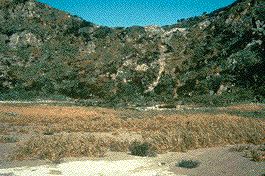Quantitative genetics - What has driven the evolution of beak sizes in Darwin's finches?

El Niņo
Four years later, in November 1982, the weather reversed. The rainfall of 1983 was exceptionally heavy and the dry volcanic landscape was covered with green in the periodic disturbance called El Niņo. The richness of the island is shown in the picture opposite.
Seed production was enormous. The theory developed for 1976 - 1978 could now be tested. The conditions had reversed: the direction of evolution should go into reverse too. In the year after the 1983 El Niņo event, there was an excess of small seeds: if the smaller finches can in fact exploit them more efficiently, the smaller finches should survive relatively better. The sizes of G. fortis on Daphne Major in 1984 - 1985 were again measured - the smaller birds were indeed favored; finches born in 1985 had beaks about 2.5% larger than those born before the El Niņo downpours. The theory that seed sizes control beak size in these finches was confirmed.
| Next |



